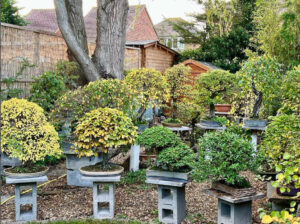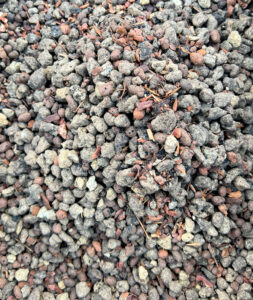Weeds can often be found growing in bonsai pots. Not only are they unsightly but their removal is necessary as they take away valuable moisture, nutrients and soil from the bonsai.
Weeds can easily find make their way into the pot; weed seeds are often blown by the wind onto the surface of the soil. Weeds themselves or their seeds can also be present in the soil that is used at repotting time, particularly if organic soil components such as leaf mould, bark or sphagnum moss are used.
But how is the best way to remove the weeds from the soil of the bonsai?
Ideally, weeding should be carried out by hand as and when any weeds emerge. If a weed becomes established in the pot, it’s roots can quickly become entangled with those of the bonsai. Pulling the weed out can then become hazardous to the bonsai itself if too much force is used; the entangled roots of the weed and the bonsai can damage those of the bonsai. The structure of the soil can also be disturbed, the removed weed roots may also take some of the soil with them, leaving voids and airpockets within the bonsai pot.
Complete removal of an established weed during the growing season is difficult to carry out without causing damage to the bonsai. Unfortunately without complete removal of the entire weed rootsystem, many weed species are able to regenerate and very possibly reappear at a later date.
A more simple and popular way of removing weeds is to spray them with a weedkiller; unfortunately this is not without risk to the bonsai……
Weedkillers
A common way of removing weeds is to use a herbicide/weedkiller. These are intended to kill the weed by entering the green tissues of the leaves, the weedkiller then travels within the weed until it enters the roots, upon which it disturbs rootgrowth and root activity. The weed may therefore take a number of days or weeks to die but with it’s rootsystem rendered ineffective, there is little chance of recovery or regeneration.
Glyphosate and RoundUp are probably the best known and most widely used weedkillers for amateur use in Europe and the USA.
It is well known that on application, great care must be taken that glyphosate/RoundUp should only come into contact with the leaves and green immature shoots of a weed; contact with the bonsai will similarly kill the bonsai.
Glyphosate/RoundUp entering the soil via run off or within the weed-roots should (and normally does) become absorbed into the soil particles and is quickly degraded by micro-organisms in the soil.
So Why Shouldn’t Glyphosate or RoundUp Be Used On A Weed Found In A Bonsai Pot?
Glyphosate/Round Up should become inert and/or heavily diluted once it comes into contact with the soil in the bonsai pot. However it can become ‘locked up’ in the soil and remain active for a period of time. As there is no warning whether the weedkiller has or hasn’t broken down successfully in the soil, it is very possible for a bonsai in the confines of a small pot to be affected by any locked up weedkiller residue without the enthusiast realising; with disastrous consequences.
According to IPM of Alaska “Glyphosate is moderately persistent in soil, with an estimated average half-life of 47 days. Reported field half-lives range from 1 to 174 days. It is strongly adsorbed by most soils, even those with lower organic and clay content. Thus, even though it is highly soluble in water, field and laboratory studies show it does not leach appreciably, and has low potential for runoff.”
(Half-life is the decay rate defined as the length of time for 1/2 of the initially measured residue to degrade)
Such a long half-life (possibly nearly 6 months) in such a small volume of soil makes the possibility of exposure to Glyphosate by the roots of a bonsai even greater.
Sinclairs ‘Diseases of Trees and Shrubs’ warns that ” in soilless media or pure sand crops (read bonsai) injury from root uptake has been observed…
Symptoms of herbicide damage: growth suppression, distorted leaves and shoots, chlorosis or bleaching, browning, leaf drop, dieback…. Very sensitive plants include: Siberian elm, willow, hackberry, grapevine, boxelder and redbud.
Some herbicides may trigger damage by secondary factors. For example, some herbicides reduce cold hardiness…”
Most worryingly, damage to bonsai by the use of weedkillers can be greatly delayed “……Injury to plants receiving small amounts of drift may be expressed one to two years after the occurrence”.
Undoubtedly, glyphosate and Round UP can and have been successfully used to kill weeds in bonsai pots for many years but there is a real risk of damage or death via soil contamination. The possible delay in reaction makes pinpointing the cause to the use of a weedkiller difficult.
In Conclusion
I would strongly suggest that weeds are regularly removed by hand as they emerge.
Established and/or deep rooted weeds should be cut back as hard as possible without trying to remove the roots. Such weeds can be easily and successfully removed at the next repotting of the bonsai.
Avoid the use of weedkillers; the risk of killing your bonsai using glyphosate or Round UP may be relatively small but it does exist.




